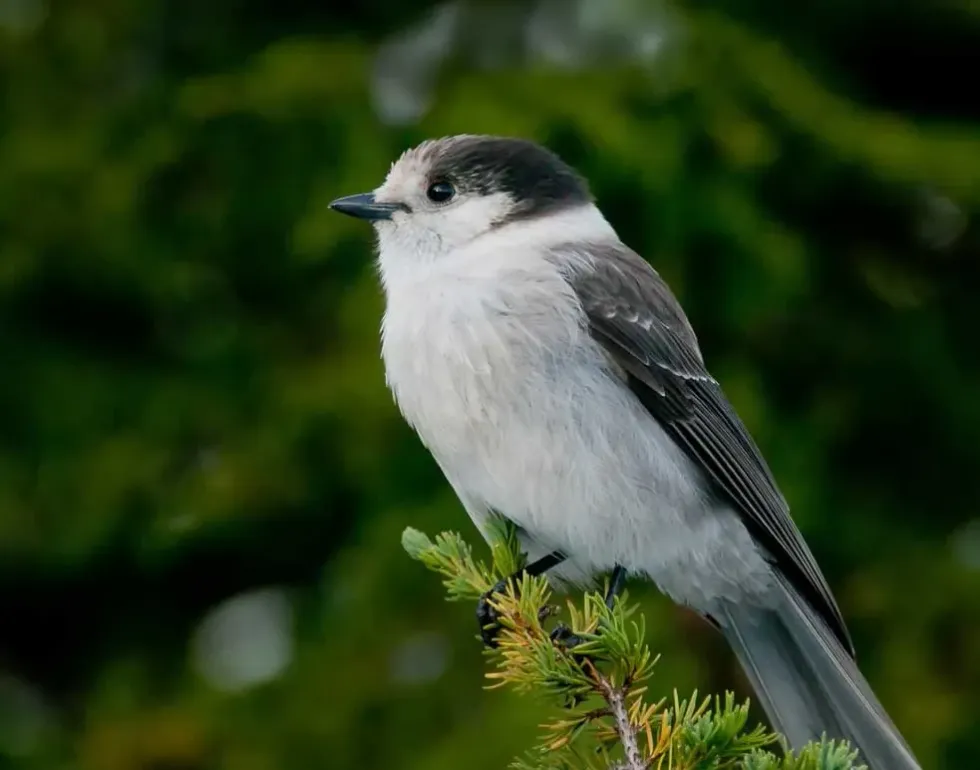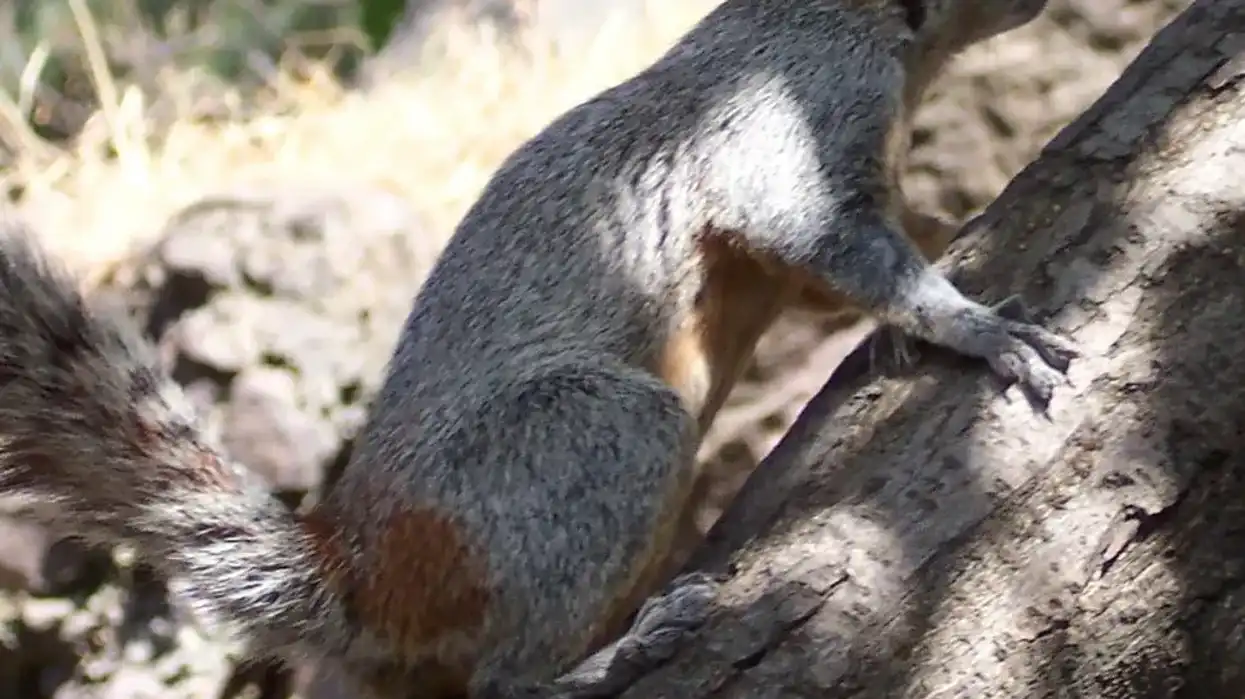Canada jay or gray jay (Perisoreus canadensis) is a medium-sized songbird found in North America. This bird looks similar to a blue jay.
These nesting birds live in boreal forests and do not migrate to other places during the winters. They are known to survive in the winter with the help of stored food.
These are omnivorous organisms that depend on fruits, seeds, insects, eggs, and nestlings of other birds. This bird is often seen stealing food from others and storing it in tree trunks and bark crevices. They then cover their food with their saliva.
These birds belong to the crow family. The population of gray jays is under control, which makes them fall under the Least Concern category. To know more about this bird and its family in detail, go through this article.
If you liked reading about these facts about the gray jay, you could also check out some facts on the northern shoveler and the spotted sandpiper.
Gray Jay Interesting Facts
What type of animal are the gray jays?
Gray jays (Perisoreus canadensis) are medium-sized nesting birds that are found in North America. They prefer spruce as their habitat.
What class of animal does a gray jay belong to?
The gray jay or Canada jay, also known as the camp robber, or whisky jack, belongs to the class of Aves and is bird species that are found breeding in the North American region.
How many gray jays are there in the world?
The gray jay range is found in Northern America, and the exact population of breeding individuals is unknown.
Where does a gray jay live?
The bird is found across Northern North America and in New York and parts of New Mexico. The population is found mostly in forests and spruce.
What is a gray jay's habitat?
The habitat of these birds includes white spruce and black spruce. They are found in the boreal forest regions and live there for a whole year and avoid migration.
Who do gray jays live with?
Gray jays are social birds and live in groups. The gray jay call helps its group members to stay attentive and protected.
How long does a gray jay live?
This bird lives for about eight years.
How do they reproduce?
Gray jays are monogamous, and females lay about two to four eggs during the breeding season. Females are attracted to the male gray jay's mating call, often heard a lot during the breeding season.
After an incubation period of 118-19 days, the eggs hatch into young chicks or nestlings. They then leave the nest 22-24 days after hatching. This species is known to attain sexual maturity after a year of birth.
What is their conservation status?
The Canada jay (Perisoreus canadensis) has a current conservation status of Least Concern. This means that we need not worry about their conservation.
Gray Jay Fun Facts
What do gray jays look like?
The blue-gray jay is a medium-sized songbird that has a lighter gray belly. They are known to have a long black tail along with a short black bill. The tail tips are white and the head of this Northern bird is white with a gray crown and white-colored forehead.
How cute are they?
Gray jays are very cute and attractive birds as they have gray-colored bodies with black beaks and feet. Canada jay nestlings are the cutest. The young gray jay bird call is very cute and soothing. These birds have many feathers, which help these nesting birds to look puffed up, which adds to their cuteness.
How do they communicate?
Gray jay calls are made in order to communicate with each other. They make sounds like 'quee-oo', chuckles, and clicks that help them communicate with each other. When predators are nearby, these birds are known to make harsh clicks and give continuous calls to convey that the predator is in the air.
This helps in alerting the entire group. During the breeding season, the male is often found singing to attract the female. When it comes to behavior, gray jays act differently when they are in danger.
How big is a gray jay?
The gray jay size is 9.8-13 in (25-33 cm) in terms of length. They weigh 2.3-2.4 oz (65-70 g).
Gray jays are fairly large nesting birds that are found in the North American forests. Gray jays can be half the size of their predators, the red-tailed hawks.
How fast can a gray jay run?
Gray jays are birds that belong to the class of Aves, so running is not their main way of moving, and they only fly to cover up distances or to search for food. The gray jay flying speed is unknown but estimated to be around 20-25 mph (32–40 kph).
These birds are fast and intelligent as they often steal food from others.
How much does a gray jay weigh?
This bird from the Northern American boreal forest weighs about 2.3-2.4 oz (65-70 g) when they are adults. The male is slightly smaller than the female. The best way to differentiate between the male and female is with the help of the male's call and how their yellow vocal bags get inflated.
What are the male and female names of the species?
The gray jay species do not have any particular names for the male or female but are also known as Canada jay. When it comes to scientific naming, these birds are referred to as Perisoreus canadensis. Because these species of birds are quite famous for their robbing abilities, they are also called camp robbers.
What would you call a baby gray jay?
The young gray jay baby does not have any names and is often called a nestling or chick when it hatches from the eggs. Young gray chicks are very cute and adorable and are known to give low-pitched cute calls.
The young nestlings are protected by both parents for a few weeks and fed by both sexes. Canada jay nestlings are very young and vulnerable on the tree nests as many other big birds predate them, so they need extra protection.
What do they eat?
As these bird species are omnivorous, the gray jays eat things like seeds, berries, insects, fungi, small rodents like mice, eggs, nestlings of other birds, small bats, shrews, and toads, other invertebrates, and carrion. This bird is known to be very clever and goes to cabins to steal food quite often.
They store their food in trees for the winter season. This species of birds are called camp robbers as they subtly steal food.
Although these birds are quite aggressive and territorial, they have natural predators too in the forests. The predators of Canada jay are merlins, red-tailed hawks, and broad-winged hawks.
Are they aggressive?
Yes, these North American birds can be very aggressive and are known to the most aggressive in their territory. They fight with other birds with complete aggression, where the other birds have to compromise on the territory and food.
The adult birds of this species are sometimes seen to raid the nests of other birds. They build their open cup nest in branches of trees and protect their territory.
Would they make a good pet?
The gray jays are not the best choice for pets but for a lonely man, they can be good to pet. The bird has a habit of stealing food in a subtle way that can even surprise humans.
They are known to have loud calls and can be irritating for some people.
Adult birds are known to be aggressive at times and even can cause serious damage in the house. The bird should not be kept as pets and moreover should be allowed to stay in their natural habitat, forests.
Did you know...
The gray jay sound is in the form of loud jeers, and this bird is also known to make whistling notes. The gray jay song is quite famous in Canadian forests. These birds do not breed in lower elevations and generally breed 2000 ft (610 m) above the tree line.
Gray jays are called whiskey jays (it has nothing to do with the alcohol). Whiskey jay is an anglicized form of Cree Wisakedjak, which is an indigenous name that is also traditional.
Jays such as pinyon jays and blue jays are known to mate for life.
If you want to attract these birds, use mealworms, suet, sunflower seeds, and cracked corn.
Gray jays are known for their famous mimicry, mimicking other owls, crows, and hawks. They are a keystone species because their micro-ecosystem would perish if it weren't for them.
Lewis and Clark found this bird near the Missouri River.
How do gray jays survive the winter?
Unlike other birds, gray jays or the Canada jays do not migrate to different places during the winter and are seen living in the Boreal forest of Canada throughout the year. In the winter, birds' survival depends on the food stored during the fall and summer.
The food is generally stored in crannies and nooks of trees and used during the winters. These birds also depend on insects, berries, fungi, and carcass meat during the winter season.
How do gray jays carry food?
Gray jays are known to carry food and save it for winters. They generally carry food with their mouth and feet, which is quite impressive for a songbird, and store food items for late winter.
This species is famous for its ability to steal food items from the campsites and is also known as a camp robber.
Therefore, the food stolen is saved for the winter months as they do not travel much during the late winter. This bird covers the food using sticky saliva and store it or paste it on tree bark crevices and bark strips.
Here at Kidadl, we have carefully created lots of interesting family-friendly facts for everyone to discover! For more relatable content, check out these Siberian jay facts and Steller's jay facts pages.
You can even occupy yourself at home by coloring in one of our free printable Gray jay coloring pages.










